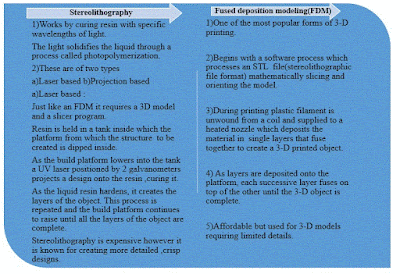3D Printing: From Stones To 3D Printing
"If a picture is worth a thousand words a prototype is worth a thousand pictures."
Most of the people now
know or at least have heard about 3-D printing. For those who have not heard of, it is the process of making three dimensional solid objects from a
digital file using a 3-D printer.
Manufacturing has always
played the most important role in all sorts of endeavour of the mankind. Printing dates back to
the time when Johannes Gutenberg
introduced printing to the Europe and the World through a printing press
thus enabling the dissemination of knowledge throughout the world in the form
of Books. At that time printing was done on 2 dimensions however, printing has
grown by leaps and bounds to manifest into its present form known as 3-D printing.
A 3-D printer can make copies of any object in 3 dimensions unlike a conventional printer thus making even the complex processes
easier many times. 3-D printing is achieved through additive manufacturing. Additive process creates objects by laying down successive layers of material
till the object is created.
Nearly three decades ago
before machine parts, toys, artificial organs were created engineer Charles
Hull printed a small cup using a plastic material and ultraviolet light. He named this process stereo-lithography and got it patented in 1986. Stereo-lithography is the
process for creating prototypes in a layer by layer fashion using
photo polymerization ,a process by which light causes chain of molecules to link
together forming polymers.It is one of the many methods for creating 3-d printed
objects.
Slowly and slowly this
new technology started gathering attention of manufacturers for use in
prototyping. Chuck Hull founded 3-D systems in 1986 to sell 3-D printers to the likes of Mercedes Benz and General motors. Competition rose in 1989
when Stratasys, another 3-D company was founded. Stratasys used Fused
deposition modeling which layer-by-layer building of the object from the bottom up
by heating and extruding thermoplastic filament through a nozzle of the 3-D printer which is called an Extruder in 3-D printing industry.
There are many processes used for 3-D printing however
the two processes mainly used for 3-D printing are Stereolithography and Fused
deposition modeling. Let’s have a look at the difference between the two:
3-D systems use stereo-lithography while companies
like Stratasys employ fused deposition modeling technology. For a more precise and
detailed objects laser based stereo-lithography process is used. Laser based process employs usually a UV laser which is focussed on to a vat of photopolymer resin. Computer aided design softwares are used to prepare designs of the object to be printed after which UV laser is used to draw the design on the photopolymer surface.Projection based lithography(DLP) employs projector below the resin
tanks to project the layers at once. DLP can print objects finer than even Laser based stereolithography however its capacity is limited in terms of volume.Whatever the processes may be but they all are being used for one or the other purpose.
3-D printing today is being used from creating
parts of planes to creating 3-D printed houses. It is also being used for creating artificial
ears,kidneys,Prosthetic Hands with the help of patient's tissues thus opening
new doors for such patients while at same time reducing the grave possibility
of rejection by the body such as in case of Kidney transplants. 3-D printing has
also been used lately to print eatable items thus bringing more options for the
customers.
Parts used in space shuttles are today being created using 3-D printing technology. 3-D printers are today being manufactured for the households
thereby enabling the customers to print whatever they need, designs for which
are available on the internet.
However, with positives every invention brings with
itself some negatives as well.Recently an activist Cody Wilson 3-D printed a gun
which created a lot of fuss in the media about the possible threats which 3-D printing brings with itself such as the existence of the design of a gun on
every computer.
So, while the advantages of 3-D printing include Rapid
prototyping, more jobs, hope for Medical patients its disadvantages include the
possible increase of Dangerous items.With the advantages of 3-D printing, mankind may be entering a new post-industrial manufacturing age where
products are significantly cheaper and built quicker than ever before, however
the disadvantages of 3-D printing needs to be known to be better understood and
mitigated against.




Great write up!!
ReplyDeleteWow. Good going bro.
ReplyDelete